
The 1948 Arab–Israeli War, also known as the First Arab–Israeli War, followed the civil war in Mandatory Palestine as the second and final stage of the 1948 Palestine war. The civil war became a war of separate states with the Israeli Declaration of Independence on 14 May 1948, the end of the British Mandate for Palestine at midnight, and the entry of a military coalition of Arab states into the territory of Mandatory Palestine the following morning. The war formally ended with the 1949 Armistice Agreements which established the Green Line.

Kiryat Shmona is a city in the Northern District of Israel on the western slopes of the Hula Valley near the Lebanese border. The city was named after the eight people, including Joseph Trumpeldor, who died in 1920 in the Battle of Tel Hai.

Joseph Vladimirovich (Volfovich) Trumpeldor was an early Zionist activist who helped to organize the Zion Mule Corps and bring Jewish immigrants to Palestine. Trumpeldor died defending the settlement of Tel Hai in 1920 and subsequently became a Jewish national hero. According to a standard account, his last words were "It's nothing, it is good to die for our country", but that he ever said these words has been challenged.

Tel Hai is a name of the former Jewish settlement in northern Galilee, the site of an early battle between Jews and Arabs heralding the growing civil conflict, and of a monument, tourist attraction, and a college. It is currently part of kibbutz Kfar Giladi.

Degania Alef is a kibbutz in northern Israel. The Jewish communal settlement (kvutza) was founded in 1910, making it the earliest socialist Zionist farming commune in the Land of Israel. Its status as "the mother of all kibbutzim" is sometimes contested based on a later distinction made between the smaller kvutza, applying to Degania in its beginnings, and the larger kibbutz.

Kfar Tavor is a village in the Lower Galilee region of Northern Israel, at the foot of Mount Tabor. Founded in 1901, it was awarded local council status in 1949. In 2022 it had a population of 4,410. As of 2017, nearly all of its citizens are Jewish.
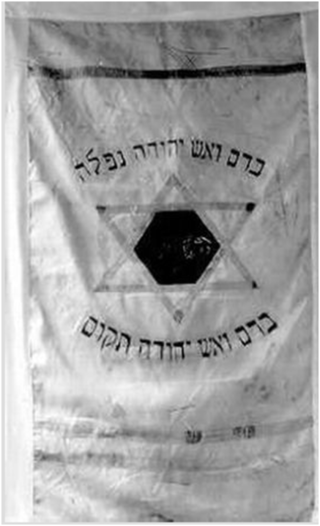
Hashomer was a Jewish defense organization in Palestine founded in April 1909. It was an outgrowth of the Bar-Giora group and was disbanded after the founding of the Haganah in 1920. Hashomer was responsible for guarding Jewish settlements in the Yishuv, freeing Jewish communities from dependence upon foreign consulates and Arab watchmen for their security. It was headed by a committee of three: Israel Shochat, Israel Giladi and Mendel Portugali.

Kfar Giladi is a kibbutz in the Galilee Panhandle of northern Israel. Located south of Metula on the Naftali Mountains above the Hula Valley and along the Lebanese border, it falls under the jurisdiction of Upper Galilee Regional Council. In 2022 it had a population of 702.

Hunin was a Palestinian Arab village in the Galilee Panhandle part of Mandatory Palestine close to the Lebanese border. It was the second largest village in the district of Safed, but was depopulated in 1948. The inhabitants of this village were, similar to the inhabitants of Southern Lebanon, Shia Muslims.
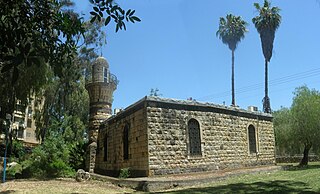
Al-Khalisa was a Palestinian Arab village situated on a low hill on the northwestern edge of the Hula Valley of over 1,800 located 28 kilometers (17 mi) north of Safad. It was depopulated in the 1948 Palestine war.

Tuba-Zangariyye or Tuba az-Zanghariyya is a Bedouin town in the Northern District of Israel. Located in the Korazim Plateau, it achieved local council status in 1988. It was formed by the merger of two villages, Tuba and az-Zangariyye. Populated by the Bedouin tribe of El Heib, Tuba is situated near Kfar Hanassi, overlooking the Jordan River, and sits 250 meters above sea level. In 2022 it had a population of 7,095.

Dafna is a kibbutz in the Upper Galilee in northern Israel. Located seven kilometres east of Kiryat Shmona and surrounded by three streams of the Dan River,it falls under the jurisdiction of Upper Galilee Regional Council. The kibbutz was founded on 3 May 1939 as a Tower and Stockade settlement, the first such settlement in the northern Hula Valley. Dafna, Beit Hillel, She'ar Yashuv and Dan were known as the "Ussishkin Fortresses", named after Menahem Ussishkin. In 2022 it had a population of 1,073.
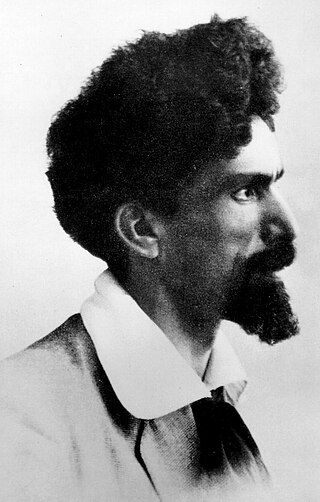
Israel Shochat was a founder of and a key figure in Bar-Giora and Hashomer, two of the precursors of the Israel Defense Forces.
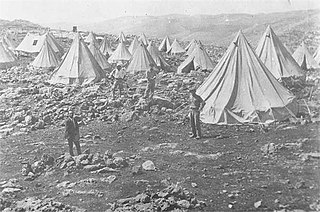
Gdud HaAvoda was a socialist Zionist work group in Mandate Palestine.
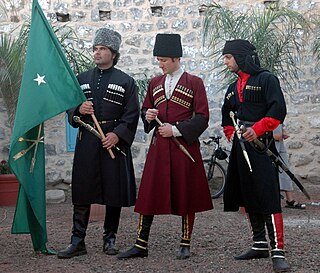
Circassians in Israel are Israelis who are ethnic Circassians. They are a branch of the Circassian diaspora, which was formed as a consequence of the 19th-century Circassian genocide that was carried out by the Russian Empire during the Russo-Circassian War; Circassians are a Northwest Caucasian ethnic group and a nation; who natively speak the Circassian languages and originate from the historical country-region of Circassia in the North Caucasus. The majority of Circassians in Israel are Muslims.

Events in the year 1920 in British-administered Palestine.

Tel Aviv and Jaffa deportation was the evacuation on April 6, 1917, of 10,000 people from Jaffa, including Tel Aviv, by the authorities of the Ottoman Empire in Palestine. The deportation mainly targeted the Jewish population of the city, resulting in the eviction of all 8,000 Jewish inhabitants. The evicted civilians were not allowed to carry off their belongings, and the deportation was accompanied by severe violence, starvation, theft, persecution and abuse. It is thought that about 1,500 of the evicted people died as a result of the deportation. Shortly after the deportation, the Muslims affected were able to return to their homes, and the Jewish population was not able to return until the summer of 1918.
This is a timeline of intercommunal conflict in Mandatory Palestine.
The Samakh raid was fought in April 1920 between Arab Bedouin irregulars under the banner of the Arab Kingdom of Syria and the British Army in Eastern Galilee. The event is perceived by scholars as part of the spillover of the Franco-Syrian War.

Avraham Melnikov was a sculptor especially notable during the period of the Yishuv. His most famous work is the monument "The Roaring Lion" at the Kfar Giladi Cemetery in Tel Hai.


















